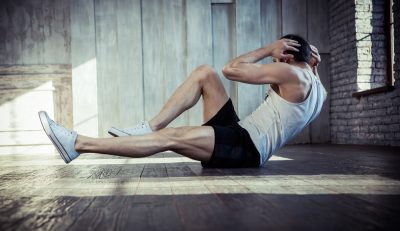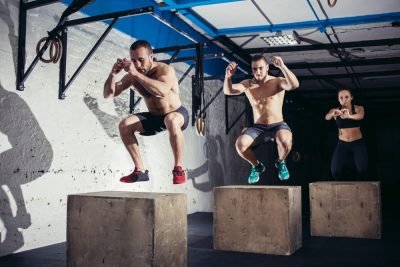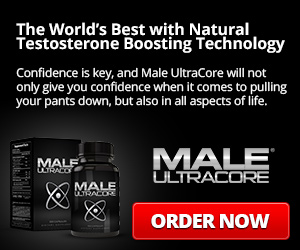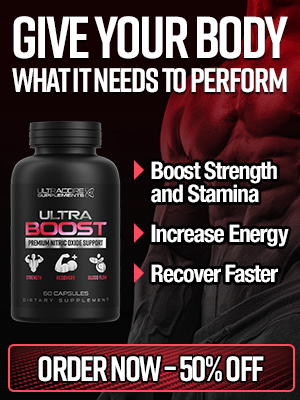If you’re reading this, you’ll have probably heard about how testosterone, resistance training and/or exercise, and lean muscle mass gains are all interconnected.
It’s not like it’s something novel, either. For what seems to be an eternity, the media has bombarded us with messages saying that testosterone boosts the production of muscle mass. There’s nothing inaccurate with that statement.
However, the close connection between testosterone and muscle mass isn’t simply limited to being a causal relationship.
Rather, the relationship is thought to be more cyclical.
Sure, testosterone increases the production of lean muscle. But the same can also be said of the opposite. That is, physical activity – exercise, for that matter – influences the body to produce more testosterone. The resulting gains then increase the body’s capability to handle more strenuous physical activity, which paves the way for even more testosterone production.
This relationship between testosterone and exercise is a continual cycle. Both high-intensity interval training (HIIT), as well as resistance training, are among the exercises that provide an acute and substantial impact on testosterone levels.
Just the mere ability to increase your testosterone levels is reason enough for starting a resistance training regimen and sticking with it all the way.
That said, let’s discuss the important role testosterone plays in the body before we examine the link between testosterone and exercise any further.
What is testosterone and how does the body produce it?
Biochemically, testosterone is an androgenic sex hormone that is also a controlled substance in certain jurisdictions.
Testosterone is produced by both men and women – in the testes for the former, and the ovaries for the latter. The adrenal glands that are located in the kidneys are also a marginal testosterone producer for men and a major testosterone producer for women.
There are yet other ways in which the body produces testosterone. In women, the hormone is converted from dehydroepiandrosterone (DHEA) within tissue, but only a minuscule amount of the testosterone you produce affects the concentrations of the hormone that are currently circulating in your body.
Nevertheless, the compound from whence all sex hormones come forth regardless of how they are produced in either gender is every cardiologist and dietitian’s arch-enemy – cholesterol.
The important role testosterone plays in men’s health
Testosterone affects a wide range of critical bodily functions. Here are some of them:
 Distribution of fat deposits in the body
Distribution of fat deposits in the body- Creation of muscle mass
- Development of strength
- Development of bone mass and density
- Production of red blood cells
- Regulation of libido
- Production of ejaculate
It’s easy to understand why the leading items in this list are important for men’s physique and appearance, not to mention performance. When your testosterone levels are in the pink of health, so does your body. There’s something about it that you know just makes it feel, look, and perform better.
The impact of low testosterone on muscle mass
Hormones are the biochemical messengers that transmit signals from the brain to your organs. They have a big influence on how you feel and how you look, depending on the information that they contain and transmit to the rest of your body.
In particular, testosterone is the hormone that tells the body to produce lean muscle by binding itself to receptors in muscle cells, and promoting protein synthesis to create more muscle tissue faster.
Your body will not be able to recover and repair itself as well as adapt to the exercise load you are doing without testosterone – that’s how important it is to the body.
In essence, low testosterone could be hampering your ability to achieve the gains you would otherwise have been able to experience if your body had better hormonal equilibrium.
More on this in just a second.
How does low testosterone interfere with your gains?
Chronic fatigue is one of the most common manifestations of imbalances in the hormones. This may include hypogonadism, hypothyroidism, and low estrogen.
Men and women suffering from low testosterone levels or any other kind of hormonal disequilibrium were found to lack the energy they once had.
This substantial loss of vitality can make working out, staying active, and performing in the bedroom all the more challenging.
How does testosterone help build muscle mass?
Hormonal imbalances present all sorts of symptoms. If you have been diagnosed with such, or suspect as much, then you’ll need to understand some truths about the body and its relation to hormones.
Testosterone levels, or hormonal levels, for that matter, are not just numbers on a screen. Something’s out of order when imbalances occur. And that imbalance is manifested by symptoms.
Fixing imbalances isn’t fixed by merely increasing the levels in terms of numbers, but rather getting your body to start firing on all cylinders to work.
The endocrine system, which is responsible for the production of hormones, is an integral part of fixing a hormonal imbalance.
Summarizing what we already know about testosterone:
- Testosterone produces lean muscle mass
- Lean muscle mass gain allows for greater increases in testosterone production
In the case of estrogen, here is what we know:
- Raised estrogen levels promote the creation of fat tissue
- Fat tissue produces estrogen, which means more fat deposits lead to more estrogen production.
It’s easy to see why this cyclical relationship can produce a rumbling crescendo of negative consequences to your body. Being unfit leads you to an unhealthy balance that’s heavy on the estrogen. And the more you delay staying in shape, the greater the imbalances that eventually drive you one step further from your health goals.
There will come a point in time where you have to decide that you want to end that self-perpetuating cycle to stop producing more fat cells, build more muscle mass, and get your endocrine system working to aid you in your goals, instead of working to sabotage you.
And this is where exercise (and proper diet and sleep) come in.
The unique dynamic between exercise and testosterone has been studied for many years. It has been found that certain exercises work that work to boost T levels more than others and eventually stabilize them to healthy working levels.
Let’s discuss them in further detail below.
How does exercise increase testosterone?
First things first: any increase in testosterone from exercise is always temporal – we’re talking about mere moments after physical activity levels drop. The good thing is, however, we’ve come up with some specific exercises that can give you an assist with the symptoms you might be experiencing.
Just the mere act of performing strenuous physical activity can already directly help certain symptoms of low T, like insomnia and depression.
Here are some exercises that help you experience an incremental boost in testosterone.
HIIT (High-Intensity Interval Training)
High-intensity interval training is typified by the repetition of short, strenuous bursts of activity that take you to your absolute limit, punctuated by short intervals of rest.
The underlying principle behind HIIT is to create an oxygen deficit that your body will be working triple time to recover from. This leads to higher metabolism levels for a few hours after completing a HIIT session, making it an extremely efficient way to burn calories, fat, and increase human growth hormone and testosterone, which the body needs for muscle growth and bone mass.
Circuit training
 Circuit training means a series of exercises that are performed in succession. Once the series is completed, you then do a short recovery break and then start the cycle again.
Circuit training means a series of exercises that are performed in succession. Once the series is completed, you then do a short recovery break and then start the cycle again.
In this regard, it’s a lot like HIIT when it comes to how it is performed, only that the underlying principle is to work out a particular set of muscle groups that prevent overtraining and the risk of injury, while giving you a fuller workout that covers a wider, more diverse set of muscle groups.
Heavier weights
If you solely want to exercise to build muscle mass and improve testosterone production, then resistance training with heavy weights is what you’ll want to do. Resistance training with heavy weights gets your muscle fibers all fired up with the heavy weight and the lower amount of reps.
It’s not as intense as HIIT may be when it comes to building an oxygen debt, but it can be just as beneficial by pushing your exertion levels to the max.
A study in 1990 suggested that lifting as much weight as you possibly can at low repetitions increases testosterone production as it requires that your body create more muscle to perform at its peak levels.
Testosterone-boosting best practices for your exercise regimen
There are more ways to implement best practices to get the most benefit out of your exercise regimen – particularly if you want to increase your testosterone levels.
Here are some ideas.
Increase the reps
Evidence suggests that testosterone levels increase by increasing the number of repetitions. Try working out with a partner who’ll be able to spot you while you ramp up your reps and your weight.
Take extended breaks
Testosterone is increased by heavy lifting. That much we know. That’s why taking extended breaks can help, particularly when you lift heavy. That’s because extended rest allows you to do more.
Ditch the jogging
We’re going to stick our necks out by saying this, but while long-distance jogging is a good cardiovascular workout that helps keep off the excess weight, it does very little to increase your testosterone.
That means you’ll have to do burpees or sprints to get that same intensity as you would doing HIIT, resistance training, or circuit training. You can incorporate jogging in your regimen, just don’t expect it to do much for your T levels as lifting heavy does.
Conclusion
If you struggle to put in time at the gym to meet your health goals due to a lack of energy or motivation despite eating right and exercising, you might want to consult your doctor about the possibility of low testosterone impeding your progress – you might just find that it was the culprit all along.
These strategies may help you get back the mojo you’ve lost and get the most out of your gym time – but it’s no substitute for getting a comprehensive consultation from your physician.








COMMENTS